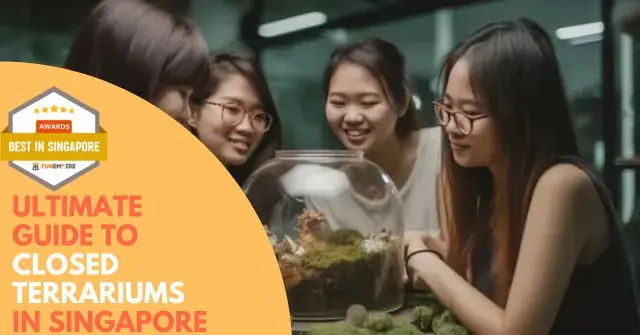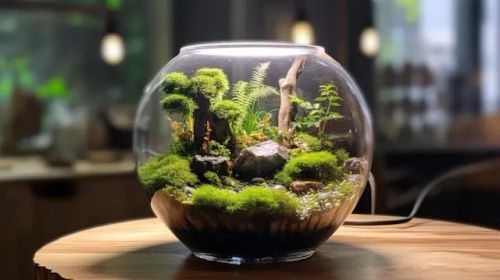Closed Terrarium Singapore

Welcome to the Ultimate Guide to Building a Closed Terrarium in Singapore for 2024!
In a closed terrarium, plants recycle moisture and air and can flourish in a small-scale ecosystem, on their own terms.
Ferns, mosses, and fittonia thrive in the humid, enclosed environment of a closed terrarium.
In our research on terrariums in Singapore, we have created this thorough guide to help you make your very own closed terrarium in the tropical climate of Singapore.
Whether it is your first time or not, this guide has the detailed step-by-step instructions you need to create your own indoor gardening space in Singapore’s climate.
Quick Summary
- Plants inside a closed terrarium recycle moisture and air, forming a self-sustaining microclimate.
- Ferns, mosses and fittonia are good plants to choose for a closed terrarium as they generate their own humid microclimate.
- Don’t overwater or place the terrarium in direct sunlight, and avoid including plants that are not suited to a humid environment.
What Does A Terrarium Mean?

There are two types of terrariums: closed and open terrariums. Closed systems are environmentally stable and humid whereas open systems are exposed to outside air and therefore get drier. We shall consider the closed type first.
Though they do take time to mature, they are as close to no-maintenance as you’re likely to find. In the right conditions, a healthy closed terrarium can go months without water.
How Do Closed Terrariums Work?

A terrarium provides by far the most satisfying example of the closed system: the biota in the soil is part of a cycle in which moisture condenses (like rain) and is recirculated.
Plants produce oxygen in light and absorb it at night.
Carbon dioxide is released during photosynthesis but balanced by plant respiration.
While terrariums can adapt, they need light and some human help to thrive.
What Plants Do Well In A Closed Terrarium?

The choice of plants in your terrarium impacts its maintenance.
Consider similar light and moisture preferences for plants to thrive.
Pick the plants meant for closed terrariums, such as mosses, ferns, or orchids. These prefer to live in a warm, humid habitat.
These plants enhance visual appeal with bright colors.
Closed Terrarium Light Requirements

Terrariums prefer gentle light. Don’t put them in direct sunlight and move them around so they aren’t exposed to intense light variations often.
If your plants are leggy, give them more light exposure; move to a sunnier spot, or add a supplemental light.
Rotate the terrarium regularly if light comes from one direction to ensure even growth.
Artificial lights offer convenience, but adjust their positioning as needed.
How To Water A Closed Terrarium

Caring for your closed terrarium plant usually requires minimal care, unlike most typical potted plants. How you can achieve mastery without daily checks? It’s all about knowing when to water your terrariums.
When watering the terrarium:
- Use purified or dechlorinated water to prevent root damage and maintain bacterial balance.
- Distilled water, due to its low mineral content, is a good option.
The soil in a healthy terrarium should be moist but not wet, so it can support both good root growth and uptake of valuable nutrients. If the soil in the terrarium is constantly saturated with water, the roots can easily rot.
Proper watering technique:
- Water the soil sparingly and tilt the container to distribute moisture evenly.
- Monitor moisture level distribution through the glass.
Avoid overwatering:
- Use a dropper, syringe, drinking straw, or small scoop for precise watering.
- For larger terrariums, use a spray bottle with medium pressure.
After watering your terrarium, open the top when the plants become dry. Collect excess water when overwatered with paper towels.
Cleaning A Closed Terrarium

For a consistently well-lit and tidy terrarium, use a commercial window cleaner on the outer glass and non-toxic products on the inside.
Wash off mineral deposits using water and white vinegar. Scrub hardscaping, wipe down soiled leaves and dry your statue thoroughly before sealing.
How To Prune A Closed Terrarium

Terrarium plants are typically low maintenance, but healthy plants require occasional trimming.
Monitor your plantings objectively to prevent overcrowding and maintain your desired aesthetic.
Consider these three factors:
- Prune plants based on individual growth rates.
- Adjust plant placement according to light exposure and growth speed.
- Prevent condensation and mold by avoiding leaves touching the glass.
Make sure that everything is sterilised before use and that the knife is sharp. Remove the leaves as soon as you see damage.
To trim overgrown leaves, pinch them at a lower node to stimulate new growth.
Utilize beheading to control plant size and promote bushier growth.
Closed Terrarium Planting Tips

To ensure closed terrariums flourish and stay visually appealing, follow these summarized tips:
- Make sure to thoroughly rinse your plants before adding them to the terrarium; you don’t want any rain, bugs, mold or other foreign chemicals.
- Add sterile soil so that pests and mould spores can’t get in. And if you’re not sure it’s clean, sterilise it anyway by baking.
- Allow plants grow naturally in the landscape before pruning as needed.
- Trim roots to keep plants to a reasonable size, preferring thread roots to tap.
- Keep greenwall plants growing well and looking good by replacing plants annually, as thriving plants outgrow typical terrarium dimensions.
Common Mistake To Avoid When Building A Closed Terrarium

- Limited Soil Space: Do not cover the soil around the stem of plants with sand because it will deprive them of water.
- Sunlight Exposure: Keep terrariums out of direct sunlight and use artificial light to prevent overheating. Keep terrariums in a cool environment.
- Avoid Overwatering: Adjust watering frequency depending on the type of terrarium. Over watering can cause mould to grow.
- Soil Quantity: Using way too much soil can hinder plants from growing when their leaves are being covered. The most of the soil should be below the leaves, heaped together around the stem.
- Fertilizer Use: Fertilisers promote sudden spurts of growth, which make maintenance more difficult Use low-growing plants for terrariums.
Closed Terrarium Singapore
Terrariums are completely self-sufficient patches of nature, working naturally in Singapore’s tropical climate.
With the right lights, waterings and plant-tending, anyone can have a miniature ecosystem in their garden, without any fuss.
Perfect for gardeners or beginners seeking a green touch indoors!
Frequently Asked Questions (FAQ)
If you have any questions about Closed Terrariums in Singapore, you can refer to the frequently asked questions (FAQ) about the Ultimate Guide to Building Closed Terrariums in Singapore below:
What’s the difference between an open terrarium and a closed terrarium?
Open terrariums are dry and suitable environment for succulents because the air can circulated freely. A closed terrarium is a sealed environment, which is suitable for water vapour and high humidity because the air can not escape the land and create a cool and humid microclimate.
How do I choose the right plants for my own terrarium?
Plants that like to be kept in high humidity and lower light levels – such as ferns, mosses and air plants – are perfectly suited to live inside a sealed glass container.
These species, growing under a water cycle and temperature controlled by a glass top, will soon adapt to the conditions inside a closed terrarium.
Carnivorous plants, for example, have slender stems with large slippery leaves that help rainwater run off them, and their low growth habit will allow sunlight to penetrate the foliage to reach the pitcher flowers below.
Non-carnivorous plants that prefer a sandy, well-drained and dryer, more ventilated habitat will find an open terrarium better suited to their needs. These include the likes of succulents or cacti, which have minimal root growth and are adapted to dry conditions.
How does the water cycle work in a closed terrarium?
In a terrarium, the water cycle is closed, self-contained. During the day, the glass container heats up from the sunlight and vapour escapes from the soil and plants.
That water vapour condenses on the walls and eventually drips back onto the soil to provide water for the plants.
The result is the miniaturisation of the natural water cycle, reducing the need to check the water.







